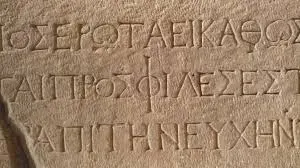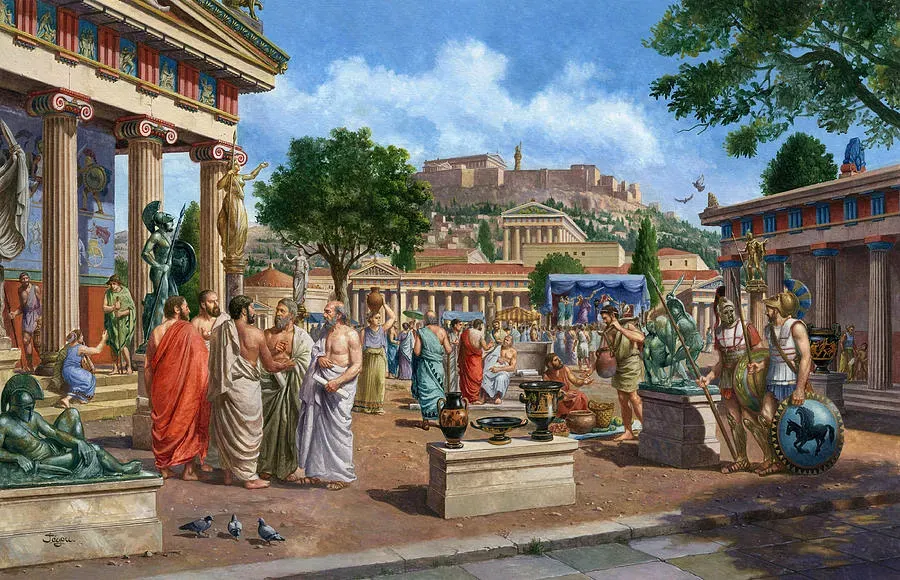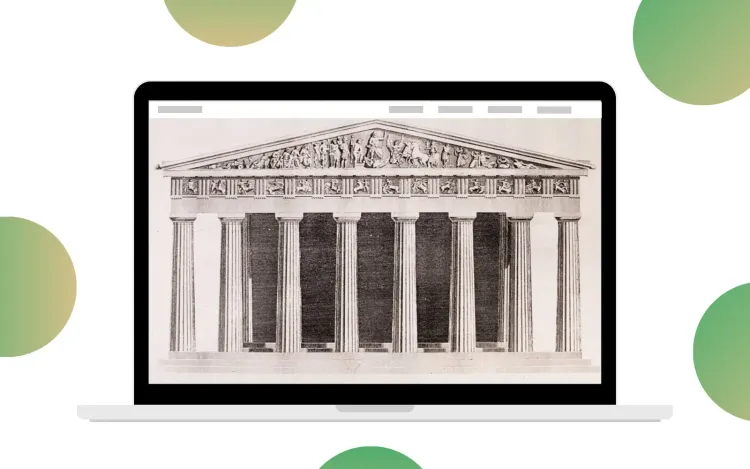Introduction
The principles governing successful web design today often attribute their origins to Silicon Valley boardrooms and 20th century design schools; however, they can also draw inspiration to a far more archaic source: Ancient Greece. When contemporary users can navigate websites with intuitive ease, appreciating layouts that feel naturally balanced and typography that guides the eye effortlessly, they are experiencing the enduring influence of design philosophies established well over 2,500 years ago.
This connection between ancient Greek architecture and modern digital interfaces extends beyond superficial aesthetic similarities. The mathematical precision that guided the construction of the Parthenon, the hierarchical organization of Greek temple complexes, and the philosophical principles underlying Greek concepts of beauty have become foundational elements in contemporary web design. Understanding these connections illuminates not only the historic continuity of human aesthetic preferences but also provides practical insights for creating more effective digital experiences.

Mathematical Foundations: The Golden Ratio's Digital Evolution
At the heart of this ancient-to-digital connection lies a mathematical relationship that has captivated designers and academics for over two millennia. The golden ratio (φ = 1.618) represents perhaps the most direct link between Greek architectural theory and contemporary web design. The Greek mathematician, Euclid, codified this proportion as fundamental to aesthetics around 300 BCE. In the Parthenon, this proportion manifests throughout the structure: the facade's height-to-width ratio measures precisely 1:1.618, while the entablature's placement corresponds to the golden ratio point of the building's total height.
This mathematical heritage did not remain buried in ancient ruins. Modern web designers have discovered that these same proportional relationships create visually satisfying digital layouts. Typography systems frequently employ golden ratio scaling, where a 16-pixel body font naturally progresses to 26-pixel headers (16 × 1.618 = 25.88). The Nielsen Norman Group, a leading authority in user experience research, explicitly recommends this mathematical approach: "The header-font size could be 16 φ = 16 x 1.618 = 25.88 or roughly 26px".

The practical application of these principles extends far beyond academic theory. When Airbnb redesigned their logo in 2014, they employed golden ratio construction to unify four distinct concepts into a single harmonious symbol (heart, location pin, person, and letter 'A'). The mathematical precision establishes subconscious visual satisfaction that contributes to the brand's global recognition and user trust (The Logo Creative).

Similarly, Pinterest exemplifies the successful application of Greek proportional principles in contemporary digital design. Their layout system follows golden spiral patterns, creating visual flow that maintains user engagement through mathematical relationships that humans find inherently pleasing.
The effectiveness of this approach is not merely anecdotal. A 2024 study conducted at the University of Texas at Arlington demonstrated that interfaces incorporating golden ratio principles achieved a 7.5% increase in user satisfaction compared to layouts using arbitrary formats. This quantifiable improvement suggests that human aesthetic preferences, even after two millennia, remain consistent across technological platforms.
Typography: From Stone to Screen
The mathematical precision that governs layout and design proportions finds its companion in the evolution of letterforms themselves. The evolution of Greek inscriptional practices into modern digital typography illustrates how practical constraints can generate lasting design principles. Unlike the opportunities of scale for Roman lettering, Greek inscriptions emphasized clarity and efficiency within limited space due to resource constraints - challenges remarkably similar to those faced by contemporary screen-based typography (Dsource).
This emphasis on efficiency over grandeur created lasting innovations in letter design. Greek stone carvers developed spacing techniques that prioritized visual balance, establishing kerning principles still used in modern typeface design. This approach recognized that different letter combinations require varying spatial intervals to maintain consistent visual texture, which is a concept fundamental to modern typography systems that ensure readability across diverse screen sizes and resolutions.

The influence of Greek letterforms extends directly into contemporary typeface design, creating a bridge between ancient craftsmanship and digital innovation. Carol Twombly's Trajan (1989) and Hermann Zapf's Optima (1958) both draw directly from Greek lapidary traditions, combining classical proportions with modern functionality. These typefaces provide a basis for professional design applications precisely because they carry the authority and elegance of classical tradition while maintaining excellent screen legibility.
Philosophical Principles in User Experience Design
Beyond mathematical relationships and letterform evolution lies a deeper connection: the philosophical frameworks that guide design decisions. Greek design philosophy introduced three concepts that remain central to contemporary user experience methodology: symmetria (balanced proportion), kalokagathia (unity of beauty and goodness), and anthropocentric (human-centered) design principles. These represented not merely aesthetic preferences but philosophical positions regarding how designed objects should serve human needs.
The principle of symmetria, that every design element should relate harmoniously to the whole, finds direct expression in modern design systems. Particularly notable is Google's Material Design, which explicitly references these classical proportional systems, creating visual languages where shadows, animations, and spacing increments work together mathematically to produce coherent user experiences.

Equally significant is the concept of kalokagathia: the Greek ideal that authentic beauty must possess moral goodness. This philosophical principle translates directly into contemporary ethical design practices, where designers should prioritize accessibility, avoid manipulative dark patterns, and respect user privacy while creating visually appealing interfaces. Apple's design philosophy exemplifies this approach, demonstrating that removing unnecessary complexity creates both aesthetic beauty and improved functionality (Medium).
These philosophical underpinnings reveal why certain design approaches feel intuitively correct while others create user friction, connecting ancient wisdom to modern usability principles.
The Agora Model: Ancient Social Networks
The philosophical principles that shaped individual design elements also influenced the organization of public spaces, establishing a legacy that profoundly impacts how we structure digital communities today. The Greek agora provides both the architectural and social template for modern digital platforms. These public squares combined commercial activity with civic engagement, creating spaces where citizens could browse merchant wares while participating in philosophical discourse and political debate. Contemporary platforms such as Facebook Marketplace, Reddit, and Amazon's review systems directly recreate this dual-function environment (Dyer).
This organizational model translates remarkably well to digital interface design. For web designers, the Greek spatial design principles from the agora translate effectively to digital interface patterns. The meandering paths between market stalls inspired the infinite scroll mechanism that sustains user engagement across social media platforms. Covered walkways that encouraged extended browsing evolved into persistent navigation systems that remain accessible throughout digital experiences.

The social dynamics of the agora prove equally relevant to digital community design. The spontaneous debates characteristic of Greek public life finds direct expression in contemporary comment sections and discussion forums. Greek urban planners understood that optimal public spaces facilitate both planned and serendipitous interactions - a principle that guides the design of successful online communities and digital marketplaces.
Conclusion and Implications for Future Digital Design
The persistence of these ancient principles across multiple technological revolutions suggests something profound about their fundamental nature. The persistence of Greek design principles across technological revolutions suggest they address fundamental aspects of human perception and cognition, rather than temporary aesthetic preferences. As interfaces evolve toward augmented reality, virtual environments, and emerging display technologies, these classical principles provide flexible frameworks rather than rigid constraints.
This continuity offers valuable guidance for contemporary designers navigating rapidly changing technological landscapes. The most successful contemporary digital experiences integrate cutting-edge technology with timeless principles of mathematical harmony, spatial logic, and human-centered design. Understanding these classical foundations enables designers to create interfaces that feel intuitive and satisfying because they align with aesthetic preferences refined over millennia.
The mathematical relationships, organizational systems, and philosophical approaches developed in ancient Greece continue to guide effective digital design because they reflect consistent patterns in human spatial cognition and aesthetic response. Rather than constraining innovation, these principles provide a stable foundation upon which creative solutions can be built, ensuring that technological advancement serves human needs rather than overwhelming them.
Works Cited
- Dsource. "Golden Ratio | Geometry in Design." D'Source Digital Online Learning Environment, 2025, www.dsource.in/course/geometry-design/golden-ratio.
- Dyer, Harry T. "Facebook Shouldn't Be Conceptualised as a Social Space; It's an Agora." Harry T Dyer, 15 Apr. 2015, harrytdyer.com/2015/04/15/facebook-shouldnt-be-contextualised-as-a-social-space-its-an-agora/.
- Google Material Design Team. "Material Design Guidelines." Google Material Design, 2025, material.io/design.
- Medium. "Apple Design Principles: A Legacy of Innovation, Elegance, and Vision." Medium, 2025, medium.com/@alexglushenkov/apple-design-principles-a-legacy-of-innovation-elegance-and-vision-6d1f99a4331b.
- Nielsen Norman Group. "The Golden Ratio and User-Interface Design." NN/g, 2025, www.nngroup.com/articles/golden-ratio-ui-design/.
- The Logo Creative. "How Top Brands Leverage the Golden Ratio in Logo Design." The Logo Creative, 2025, www.thelogocreative.co.uk/how-top-brands-leverage-the-golden-ratio-in-logo-design-secrets-revealed/.
- University of Texas at Arlington. "The Golden Ratio in Classical and Contemporary Design Merges." UTA Honors Research, 2025, mavmatrix.uta.edu/honors_spring2025/38/.
Weekly Insights
Get actionable web development tips that actually work. No fluff, just proven strategies.
Join 5,000+ developers and business owners worldwide
Weekly insights • No spam • Unsubscribe anytime

Jackson White
Content Creator
Jackson is the founder and lead developer at Launch Turtle, bringing over 4 years of technical expertise to help small and mid-sized businesses establish powerful online presences. Let's Launch!
